Ectopic expression of the neuropeptide pigment-dispersing factor alters behavioral rhythms in Drosophila melanogaster
- PMID: 10777797
- PMCID: PMC6773135
- DOI: 10.1523/JNEUROSCI.20-09-03339.2000
Ectopic expression of the neuropeptide pigment-dispersing factor alters behavioral rhythms in Drosophila melanogaster
Abstract
To study the function of the neuropeptide pigment-dispersing factor (PDF) in the circadian system of Drosophila, we misexpressed the pdf gene from the grasshopper Romalea in the CNS of Drosophila and investigated the effect of this on behavioral rhythmicity. pdf was either ectopically expressed in different numbers of neurons in the brain or the thoracical nervous system or overexpressed in the pacemaker neurons alone. We found severe alterations in the activity and eclosion rhythm of several but not all lines with ectopic pdf expression. Only ectopic pdf expression in neurons that projected into the dorsal central brain severely influenced activity rhythms. Therefore, we conclude that PDF acts as a neuromodulator in the dorsal central brain that is involved in the rhythmic control of behavior. Overexpression of pdf in the pacemaker neurons alone or in the other neurons that express the clock genes period (per) and timeless (tim) did not disturb the activity rhythm. Such flies still showed a rhythm in PDF accumulation in the central brain terminals. This rhythm was absent in the terminals of neurons that expressed PDF ectopically. Probably, PDF is rhythmically processed, transported, or secreted in neurons expressing per and tim, and additional PDF expression in these cells does not influence this rhythmic process. In neurons lacking per and tim, PDF appears to be continuously processed, leading to a constant PDF secretion at their nerve terminals. This may lead to conflicting signals in the rhythmic output pathway and result in a severely altered rhythmic behavior.
Figures

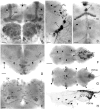


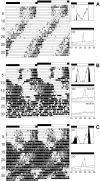
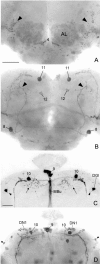
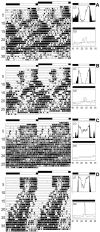

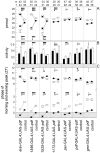

Similar articles
-
Disruption of synaptic transmission or clock-gene-product oscillations in circadian pacemaker cells of Drosophila cause abnormal behavioral rhythms.J Neurobiol. 2000 Jun 5;43(3):207-33. doi: 10.1002/(sici)1097-4695(20000605)43:3<207::aid-neu1>3.0.co;2-0. J Neurobiol. 2000. PMID: 10842235
-
The Drosophila Receptor Protein Tyrosine Phosphatase LAR Is Required for Development of Circadian Pacemaker Neuron Processes That Support Rhythmic Activity in Constant Darkness But Not during Light/Dark Cycles.J Neurosci. 2016 Mar 30;36(13):3860-70. doi: 10.1523/JNEUROSCI.4523-15.2016. J Neurosci. 2016. PMID: 27030770 Free PMC article.
-
Development of PDF-immunoreactive cells, possible clock neurons, in the housefly Musca domestica.Microsc Res Tech. 2003 Oct 1;62(2):103-13. doi: 10.1002/jemt.10365. Microsc Res Tech. 2003. PMID: 12966497
-
Mechanisms of clock output in the Drosophila circadian pacemaker system.J Biol Rhythms. 2006 Dec;21(6):445-57. doi: 10.1177/0748730406293910. J Biol Rhythms. 2006. PMID: 17107935 Review.
-
Downloading central clock information in Drosophila.Mol Neurobiol. 2002 Oct-Dec;26(2-3):217-33. doi: 10.1385/MN:26:2-3:217. Mol Neurobiol. 2002. PMID: 12428757 Review.
Cited by
-
Persistence of morning anticipation behavior and high amplitude morning startle response following functional loss of small ventral lateral neurons in Drosophila.PLoS One. 2010 Jul 16;5(7):e11628. doi: 10.1371/journal.pone.0011628. PLoS One. 2010. PMID: 20661292 Free PMC article.
-
The circadian clock in the brain: a structural and functional comparison between mammals and insects.J Comp Physiol A Neuroethol Sens Neural Behav Physiol. 2004 Aug;190(8):601-13. doi: 10.1007/s00359-004-0527-2. Epub 2004 May 20. J Comp Physiol A Neuroethol Sens Neural Behav Physiol. 2004. PMID: 15156341 Review.
-
Neural mechanism of circadian clock-based photoperiodism in insects and snails.J Comp Physiol A Neuroethol Sens Neural Behav Physiol. 2024 Jul;210(4):601-625. doi: 10.1007/s00359-023-01662-6. Epub 2023 Aug 18. J Comp Physiol A Neuroethol Sens Neural Behav Physiol. 2024. PMID: 37596422 Free PMC article. Review.
-
Circadian biology: the supporting cast takes on a starring role.Curr Biol. 2011 May 10;21(9):R313-4. doi: 10.1016/j.cub.2011.03.056. Curr Biol. 2011. PMID: 21549951 Free PMC article.
-
Mmp1 processing of the PDF neuropeptide regulates circadian structural plasticity of pacemaker neurons.PLoS Genet. 2014 Oct 30;10(10):e1004700. doi: 10.1371/journal.pgen.1004700. eCollection 2014 Oct. PLoS Genet. 2014. PMID: 25356918 Free PMC article.
References
-
- Albers HE, Liou S-Y, Stopa EG, Zoeller RT. Neurotransmitter colocalization and circadian rhythms. Prog Brain Res. 1992;92:289–307. - PubMed
-
- Aréchiga H, Cortes JL, Farcia U, Rodrigues-Sosa L. Neuroendocrine correlates of circadian rhythmicity in Crustaceans. Am Zool. 1985;25:265–274.
-
- Brand A. GFP in Drosophila. Trends Genet. 1995;11:324–325. - PubMed
-
- Brand AH, Perrimon N. Targeted gene expression as a means of altering cell fates and generating dominant phenotypes. Development. 1993;118:401–415. - PubMed
Publication types
MeSH terms
Substances
LinkOut - more resources
Full Text Sources
Molecular Biology Databases
